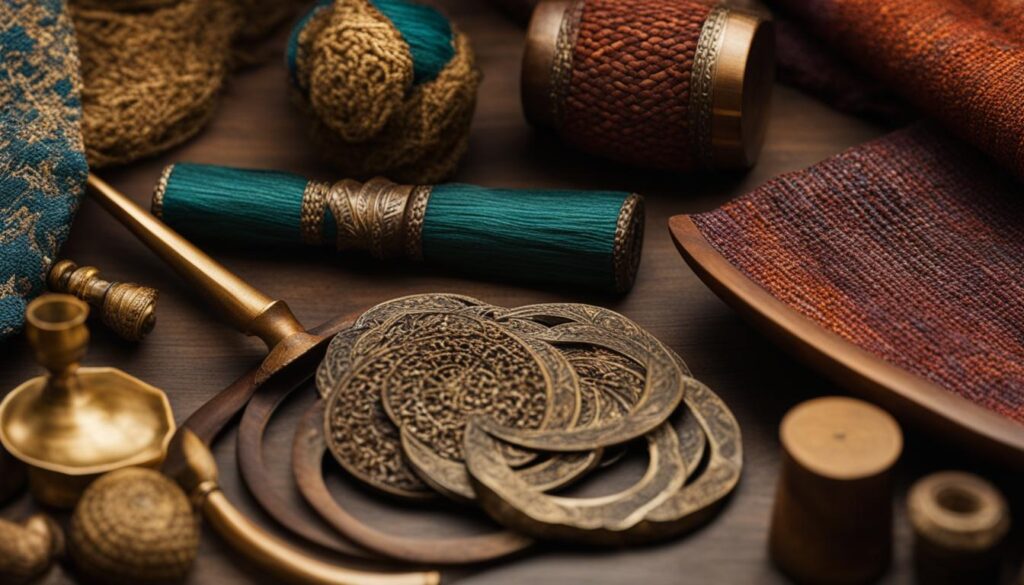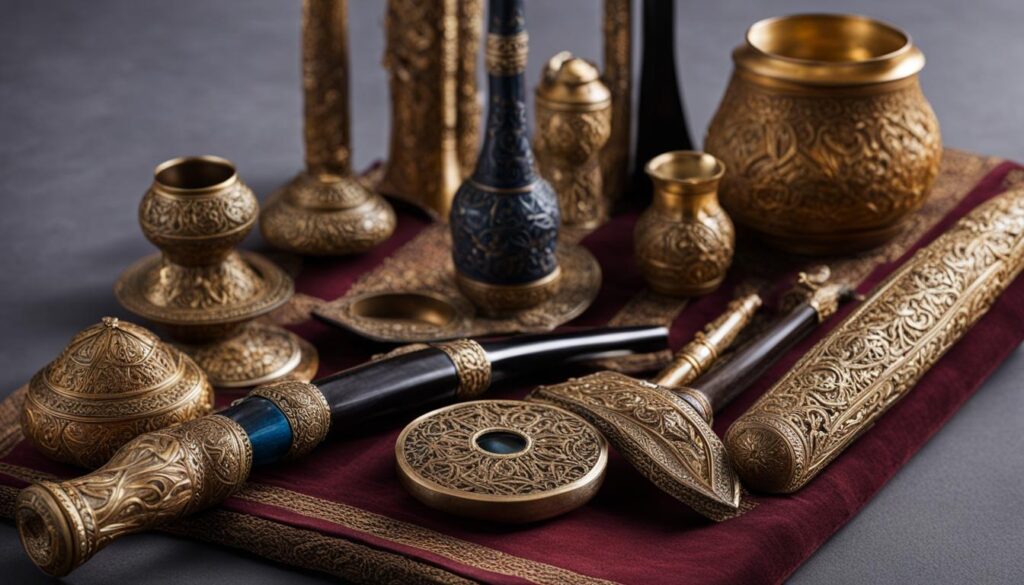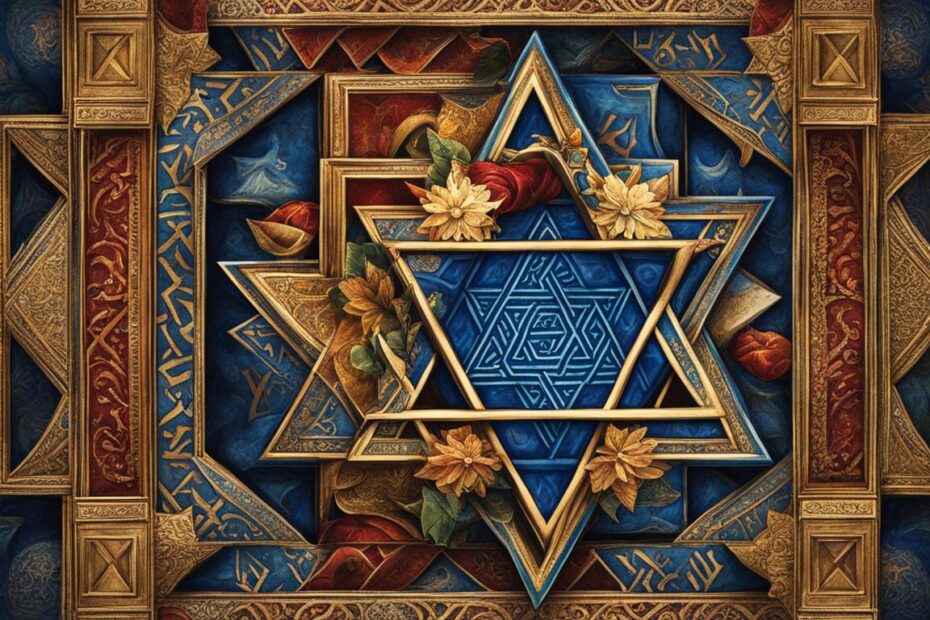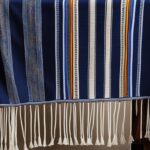Judaism is a profound and complex religion with a rich history and deep traditions. From the study of Torah to the observance of kosher laws and the celebration of Jewish holidays, there are many facets to explore. This guide will delve into the various aspects of Judaism, providing valuable insights and understanding.
Key Takeaways:
- Judaism is a complex and profound religion with rich traditions and practices.
- Prayer tools such as the tallit, tefillin, and siddur are essential in Jewish worship.
- These prayer tools hold deep symbolic meaning and enhance the spiritual connection.
- There are variations in the use of prayer tools among different Jewish sects.
- Materials used for prayer tools include wool, leather, and various contemporary materials.
Understanding the Essential Prayer Tools in Judaism
Prayer is an integral part of the Jewish tradition, and it is accompanied by specific tools that enhance the spiritual experience. These prayer tools hold deep symbolic meaning and are used in various ways during worship. The three main prayer tools in Judaism are the tallit, tefillin, and siddur.
| Prayer Tool | Symbolic Meaning | Usage |
|---|---|---|
| Tallit | The tallit, also known as the prayer shawl, represents the presence of God and serves as a reminder of the commandments. It is typically worn during morning prayers, on Jewish holidays, and on Shabbat. | Worn by wrapping it around the shoulders and draping it over the body while reciting prayers. |
| Tefillin | Tefillin, also called phylacteries, symbolize the Jewish people’s commitment to the teachings of the Torah. They consist of small black boxes containing verses from the Torah, which are tied to the arm and forehead with leather straps. | Bound to the non-dominant arm and placed on the forehead during morning prayers. |
| Siddur | The siddur is a prayer book containing a collection of Jewish prayers and blessings. It acts as a guide for individuals to connect with God and their spiritual heritage. | Used to recite prayers and blessings during synagogue services and personal worship. |
While the specific usage and customs surrounding these prayer tools may vary among different Jewish sects, they are considered essential components of the Jewish prayer experience. These tools, with their profound symbolism and deep-rooted traditions, foster a sense of spirituality and connection to the divine.
“Prayer is not asking. It is a longing of the soul. It is daily admission of one’s weakness. It is better in prayer to have a heart without words than words without a heart.” – Mahatma Gandhi
The Symbolic Meaning of Jewish Prayer Tools
The prayer tools in Judaism are not just practical items, but they also hold deep symbolic meaning. Understanding the symbolism behind these tools enhances the prayer experience and fosters a deeper spiritual connection. Let’s explore the main prayer tools and their significance:
Tallit – The Prayer Shawl
The tallit, or prayer shawl, is an essential prayer tool in Judaism. It is traditionally worn during morning prayers and certain holiday services. The tallit represents the presence of God and serves as a reminder of the commandments. The fringes, known as tzitzit, are tied in a specific manner to symbolize the 613 commandments of the Torah. By wearing the tallit, individuals not only fulfill a religious obligation but also enter into a state of prayerful devotion, enveloped in the symbolic embrace of God’s love.
Tefillin – Phylacteries
Tefillin are small black leather boxes containing passages from the Torah. They are worn on the arm and forehead during morning prayers on weekdays. The tefillin symbolize the Jewish people’s commitment to the teachings of the Torah. Through the act of binding the tefillin to their bodies, individuals express their desire to bind their hearts, thoughts, and actions to the divine commandments. The tefillin serve as a tangible reminder of the spiritual connection between individuals and the sacred texts of Judaism.
Siddur – Prayer Book
The siddur is a prayer book that contains a collection of prayers, blessings, and psalms. It serves as a guide for individuals to connect with God and their spiritual heritage. The siddur not only provides the words for prayer but also offers a structured framework for communal and personal worship. Each prayer and blessing within the siddur holds its own symbolism, allowing individuals to express their gratitude, seek forgiveness, and find solace in the divine presence.
By understanding the symbolic meaning of Jewish prayer tools, individuals can deepen their prayer experiences and cultivate a stronger spiritual connection. These tools serve as powerful reminders of the traditions, beliefs, and values that have guided the Jewish people throughout history. Whether wearing the tallit, binding the tefillin, or reciting prayers from the siddur, each act becomes an opportunity to engage with the divine and draw closer to the essence of Judaism.
Variations in Prayer Tools among Jewish Sects
Within Judaism, prayer tools are used in various ways to connect with the divine and uphold religious practices. However, there are notable variations among different Jewish sects in the use and interpretation of these tools. Orthodox Judaism tends to adhere strictly to traditional practices and places a strong emphasis on following religious laws. As such, prayer tools are used with exacting precision, following specific rituals and guidelines.
On the other hand, Reform Judaism adopts a more flexible approach, allowing for modifications or omissions of certain prayer tools. The focus is often placed on the personal connection with God rather than strict adherence to established traditions. This can lead to a more open interpretation of prayer tools and practices.
“While Orthodox Judaism maintains the use of traditional prayer tools, such as the tallit, tefillin, and siddur, Reform Judaism may choose to adapt or disregard these tools based on individual and communal preferences.”
Other sects within Judaism, such as Conservative Judaism and Reconstructionist Judaism, fall somewhere in between Orthodox and Reform practices. They may adopt varying levels of tradition and innovation, resulting in unique approaches to prayer tools. Understanding these differences provides valuable insight into the diversity and adaptability of the Jewish faith.
| Jewish Sect | Approach to Prayer Tools |
|---|---|
| Orthodox Judaism | Strict adherence to traditional practices; prayer tools used with precision and exact rituals. |
| Reform Judaism | More flexible approach with potential modifications or omissions of certain prayer tools. |
| Conservative Judaism | Falls between Orthodox and Reform practices; adopts varying levels of tradition and innovation. |
| Reconstructionist Judaism | Blends tradition with contemporary practices; emphasizes communal participation and personal connection. |
These variations in the use of prayer tools among different Jewish sects highlight the dynamic nature of Judaism and the ability of individuals and communities to adapt religious practices to suit their needs and beliefs. The common thread that runs through all sects is the intention to connect with the divine and enhance spirituality through prayer.
Materials Used for Jewish Prayer Tools
Prayer tools in Judaism have a long history and are made with specific materials that hold symbolic meaning. These materials have evolved over time, reflecting changes in design and contemporary practices while maintaining a connection to tradition.
Sources of Materials
The choice of materials for prayer tools in Judaism is rooted in both practicality and symbolism. Traditional materials such as wool, leather, and parchment are still commonly used, while modern materials like synthetic fibers and paper have also found their place.
Wool is the primary material for the tallit, symbolizing warmth, protection, and the divine presence. The use of leather for crafting tefillin represents the sacredness of the Jewish scriptures and the commitment to their teachings. Siddurim, prayer books, can be found in various materials, including traditional parchment, contemporary paper, and durable synthetic materials. These choices allow for the preservation of tradition and the adaptation to contemporary prayer practices.
Symbolism and Adaptation
The materials used for prayer tools in Judaism offer deeper symbolic connections to the rituals and beliefs of the religion. The choice to use traditional materials emphasizes a connection to the past and the preservation of Jewish heritage. Simultaneously, the incorporation of contemporary materials demonstrates the adaptability of Judaism and its ability to thrive in modern times.
For example, the use of synthetic materials in siddurim ensures durability and longevity, making them suitable for everyday use and travel. This adaptation allows individuals to carry their prayer books wherever they go and easily access the prayers and blessings that connect them to their spiritual heritage.

Evolution of Jewish Prayer Tools
In the realm of Judaism, prayer tools hold a significant place in religious practice and spiritual connection. Over time, these tools have undergone a process of evolution and modernization, reflecting the historical context and changing needs of worshipers. Understanding the evolution of Jewish prayer tools provides valuable insights into the dynamic nature of the religion and its ability to adapt while preserving its core values.
The evolution of Jewish prayer tools can be seen in various aspects, including their design, materials used, and symbolic significance. For example, the tallit, once a simple garment, has transformed into an elaborate shawl with decorative elements. This evolution not only adds aesthetic value but also enhances the worship experience. Similarly, tefillin, which were traditionally made from leather, have seen modifications in their design to provide comfort and ease of use.
One of the driving forces behind the evolution of prayer tools is the historical context in which Judaism has developed. As Jewish communities moved and flourished in different regions, prayer tools were adapted to local customs and preferences. This allowed for a more inclusive worship experience and fostered a sense of belonging among worshippers. The evolution of Jewish prayer tools is a testament to the resilience and adaptability of Judaism as a religion.
| Prayer Tool | Evolution |
|---|---|
| Tallit | Transitioned from a simple garment to an elaborate shawl with decorative elements |
| Tefillin | Design modifications for improved comfort and ease of use |
| Siddur | Inclusion of translations and adaptations to meet the needs of different communities |
“The evolution of Jewish prayer tools is a reflection of the changing needs and contexts of worship,” said Rabbi Rachel Steinberg. “It demonstrates the beauty of Judaism’s ability to adapt while maintaining its core values.”
Modernization and Inclusivity
As Judaism continues to evolve, prayer tools are also adapting to modern practices and fostering inclusivity. For instance, the use of electronic siddurim has become more common, allowing individuals to access prayers in digital formats. This modernization not only caters to the technological advancements of the modern era but also facilitates a more accessible prayer experience for differently abled individuals.
Furthermore, prayer tools are evolving to be more inclusive of diverse gender identities. The traditional tallit and tefillin, once predominantly associated with male worshipers, are now embraced by people of all genders. This inclusivity reflects the changing dynamics of Jewish communities and the desire to create an environment where everyone can fully participate and engage in prayer.
In conclusion, the evolution of Jewish prayer tools highlights the dynamic nature of Judaism and its ability to adapt to the historical context and changing needs of worshipers. Through the process of modernization and inclusivity, these tools continue to facilitate a deep spiritual connection for individuals of all backgrounds and identities.
Lesser-Known Prayer Tools in Judaism
While the tallit, tefillin, and siddur are widely recognized prayer tools in Judaism, there are also lesser-known tools that hold significance in certain religious practices. These tools, often steeped in symbolism, add depth to the prayer experience and connect individuals to their spiritual heritage.
One such tool is the yad, or Torah pointer, which is used during the reading of the Torah. The yad is traditionally made of silver or another precious metal, and its purpose is to prevent direct contact with the sacred scroll while guiding the reader’s focus. It serves as a physical extension of the hand, emphasizing the reverence and respect given to the text of the Torah.
“The yad is a powerful symbol of the connection between the Jewish people and their sacred scriptures,” says Rabbi Rachel Kleinman. “By using the yad, we demonstrate our commitment to preserving and understanding the wisdom contained within the Torah.”
Another lesser-known prayer tool is the shofar, a ram’s horn that is blown during specific Jewish holidays, most notably Rosh Hashanah, the Jewish New Year. The shofar’s distinct sound carries deep spiritual significance, symbolizing repentance, awakening, and the call to gather as a community. It is believed to create a direct connection between worshippers and the divine.
| Prayer Tool | Usage | Symbolism |
|---|---|---|
| Yad (Torah Pointer) | Used during the reading of the Torah | Guidance, reverence, connection to sacred texts |
| Shofar (Ram’s Horn) | Blown during specific Jewish holidays | Repentance, awakening, connection to the divine |
By familiarizing oneself with these lesser-known prayer tools, individuals can gain a deeper understanding of Jewish religious practices and the rich symbolism that permeates the religion. These tools serve as tangible reminders of the profound connection between worshippers and their spiritual heritage, enhancing the prayer experience and fostering a sense of unity within the Jewish community.

Exploring the World of Jewish Literature
Jewish literature is a treasure trove of knowledge and wisdom, offering deep insights into the teachings, traditions, and values of Judaism. From religious texts and commentaries to modern works exploring Jewish identity and spirituality, the breadth and depth of Jewish literature are truly remarkable. Whether you are looking to deepen your understanding of Jewish religious practices or simply want to appreciate the beauty of Jewish storytelling, there are numerous books that can guide and inspire you on your journey.
The Power of Jewish Literature
Jewish literature serves as a window into the complexities of Jewish life, history, and thought. It explores fundamental concepts such as God, morality, and the human condition, providing readers with a deeper understanding of Jewish religious teachings. It also delves into the rich tapestry of Jewish history, shedding light on significant events, figures, and movements that have shaped the Jewish people throughout the ages.
“Reading Jewish literature is like embarking on a journey through time and space, enabling us to connect with the collective wisdom of our ancestors and engage with the profound questions of our existence.” – Rabbi Sarah Cohen
Recommended Books on Jewish Literature
For those seeking an introduction to Jewish literature, “Jewish Literacy” by Rabbi Joseph Telushkin is an excellent starting point. It provides an overview of Jewish history, culture, and beliefs, offering readers a comprehensive foundation in Jewish literacy. For a deeper exploration of Jewish spirituality, “To Life!: A Celebration of Jewish Being and Thinking” by Rabbi Harold Kushner is a thought-provoking read that delves into the meaning and purpose of Jewish existence.
For individuals looking to explore their Jewish identity and find deeper meaning in their lives, “Here All Along: Finding Meaning, Spirituality, and a Deeper Connection to Life — in Judaism” by Sarah Hurwitz offers a personal and relatable journey through Jewish teachings and practices. These books, among many others, open doors to the rich tapestry of Jewish literature, inviting readers to engage with the profound wisdom and beauty it holds.
| Book Title | Author |
|---|---|
| Jewish Literacy | Rabbi Joseph Telushkin |
| To Life!: A Celebration of Jewish Being and Thinking | Rabbi Harold Kushner |
| Here All Along: Finding Meaning, Spirituality, and a Deeper Connection to Life — in Judaism | Sarah Hurwitz |

Immerse yourself in the world of Jewish literature and discover the profound wisdom and beauty it offers. Whether you are new to Judaism or a seasoned practitioner, these books provide invaluable insights and guidance on your spiritual journey. Through the power of storytelling, Jewish literature bridges the gap between the past and the present, connecting generations and nourishing the soul.
Exploring the Role of Challah in Jewish Tradition
Jewish tradition is rich with symbolism and rituals, and one of the most beloved and iconic elements is challah, a special bread associated with the observance of Shabbat. Challah holds significant cultural and religious importance, representing both sustenance and spirituality in Jewish tradition.
The word “challah” comes from the Hebrew word “challah,” which means “portion.” This refers to the commandment in the Torah to separate a portion of dough as an offering to God. In practice, challah is typically braided or shaped into spiral loaves, which are not only visually appealing but also hold deeper meanings.
Each strand of the braided challah is said to represent different aspects of Jewish life and faith, such as love, unity, and remembrance. The spiral shape is reminiscent of the cyclical nature of time and the ongoing commitment to observing Shabbat week after week. By partaking in challah, Jews connect to their heritage and affirm their faith.

The Significance of Challah on Shabbat
On Shabbat, the Jewish day of rest, challah takes on an even greater significance. The challah loaves are usually covered with a decorative cloth, symbolic of the dew that fell from heaven to provide nourishment for the Israelites during their wanderings in the desert. This cloth covering, known as a challah cover, helps preserve the spiritual and sacred nature of the bread.
Before eating challah, a special blessing called Hamotzi is recited, acknowledging God as the provider of sustenance. The challah is then sliced and shared with family and friends, symbolizing the unity and fellowship that accompany the Shabbat observance.
Challah is not only enjoyed during Shabbat but also holds significance during Jewish holidays, such as Rosh Hashanah and Sukkot. For Rosh Hashanah, the Jewish New Year, round challah is often baked to symbolize the cyclical nature of life and the continuous renewal of faith. During Sukkot, the harvest festival, it is customary to eat meals in a sukkah (temporary outdoor shelter) and enjoy meals that include challah.
Challah: A Symbol of Jewish Tradition
Challah not only satisfies physical hunger but also nourishes the soul and serves as a reminder of the rich traditions and values of Judaism. It is a unifying force that brings families and communities together, fostering a sense of belonging and connection.
The Significance of Kabbalah in Jewish Mysticism
Kabbalah is a mystical tradition within Judaism that explores the deeper spiritual dimensions of the religion. Rooted in ancient Jewish texts and teachings, Kabbalah offers seekers a pathway to connect with the divine and unravel the mysteries of the universe. It provides a framework for understanding the hidden aspects of reality, the nature of God, and the soul’s journey towards enlightenment.
In Jewish mysticism, Kabbalah delves into esoteric concepts and symbols, examining the relationship between the physical and spiritual realms. It delves into topics such as the sefirot – the ten divine attributes through which God interacts with the world, and the study of the Zohar – a central text in Kabbalistic literature. By engaging with these mystical teachings, practitioners seek to attain spiritual growth, gain insights into the deeper meaning of existence, and develop a closer connection with the divine.
Throughout history, Kabbalah has captivated the minds and hearts of scholars, mystics, and spiritual seekers. Its profound teachings have influenced Jewish thought and practice, as well as inspiring individuals from various backgrounds to embark on a spiritual exploration. Kabbalah acknowledges the profound mysteries of life and offers tools and practices to navigate these depths, providing a unique and transformative spiritual path within the broader tapestry of Judaism.

Kabbalistic Concepts and Practices
Within Kabbalah, there are various concepts and practices that play an important role in spiritual exploration. These include meditation, visualization, and the study of sacred texts. Meditation allows individuals to quiet the mind, focus their awareness, and open themselves to spiritual insights. Visualization techniques, such as picturing the sefirot, can help cultivate a deeper understanding of the divine attributes and their interplay. The study of sacred texts, particularly the Zohar, reveals layers of wisdom and symbolism that invite contemplation and reflection.
Additionally, Kabbalah emphasizes the importance of ethical conduct and inner transformation. Practitioners are encouraged to cultivate qualities such as compassion, kindness, and humility, seeing these as integral to the spiritual journey. Through the integration of these values into daily life, one can align their actions with their spiritual aspirations, fostering personal growth and contributing to the betterment of the world.
| Kabbalistic Concepts | Practices and Techniques |
|---|---|
| Meditation | Quieting the mind, focusing awareness |
| Visualization | Picturing the sefirot, exploring divine attributes |
| Study of Sacred Texts | Zohar, exploration of layers of wisdom and symbolism |
| Ethical Conduct | Cultivating compassion, kindness, and humility |
As with any mystical tradition, the study and practice of Kabbalah require dedication, an open mind, and a willingness to delve into the depths of one’s spirituality. It is a journey of seeking, questioning, and connecting with the divine on a profound level. Whether one is new to Kabbalah or a seasoned practitioner, its teachings continue to inspire and guide individuals in their quest for spiritual enlightenment and a deeper understanding of the universe.
Conclusion
Judaism is a rich tradition with a deep spirituality that invites exploration and understanding. Through the use of prayer tools, such as the tallit, tefillin, and siddur, individuals engage in a meaningful connection with their faith. These tools symbolize the presence of God, the commitment to Torah, and the connection to Jewish heritage.
While prayer tools are essential components of Jewish worship, there are variations in their usage among different sects. Orthodox Judaism maintains strict adherence to traditional practices, while Reform Judaism embraces flexibility and may modify or omit certain tools. This diversity reflects the dynamic nature of Judaism and the different ways in which individuals connect with their spirituality.
Over time, prayer tools have evolved in materials and design. The tallit, traditionally made of wool, has transformed into a more elaborate shawl. Tefillin, crafted from leather, have seen modifications in their shape and style. These changes honor tradition while adapting to contemporary practices, allowing individuals to engage in prayer with reverence and relevance.
In addition to the well-known prayer tools, there are lesser-known tools that hold significance in certain religious practices. The yad, or Torah pointer, aids in reading the Torah, while the shofar, a ram’s horn, is blown during specific Jewish holidays. Familiarizing oneself with these lesser-known tools deepens the understanding and appreciation of Jewish religious practices.
FAQ
What are the essential prayer tools in Judaism?
The essential prayer tools in Judaism include the tallit (prayer shawl), tefillin (phylacteries), and siddur (prayer book).
What is the symbolic meaning of Jewish prayer tools?
The tallit represents the presence of God and the commandments, tefillin symbolize the commitment to the teachings of the Torah, and the siddur connects individuals to God and their spiritual heritage.
How do different Jewish sects use prayer tools?
Different Jewish sects may have variations in the use and interpretation of prayer tools. Orthodox Judaism tends to adhere to traditional practices, while Reform Judaism may adopt more flexible approaches.
What materials are used for Jewish prayer tools?
Traditionally, the tallit is made of wool, tefillin are crafted from leather, and siddurim are made from various materials like parchment or modern books.
How have Jewish prayer tools evolved over time?
Jewish prayer tools have evolved to suit the needs and preferences of worshippers. For example, the tallit has transitioned from a simple garment to a more elaborate shawl, and tefillin have seen modifications in their design.
Are there any lesser-known prayer tools in Judaism?
Yes, lesser-known prayer tools include the yad (Torah pointer) used for reading the Torah and the shofar (ram’s horn) blown during specific Jewish holidays.
What are some recommended books for learning about Judaism?
“Jewish Literacy” by Rabbi Joseph Telushkin, “To Life!: A Celebration of Jewish Being and Thinking” by Rabbi Harold Kushner, and “Here All Along: Finding Meaning, Spirituality, and a Deeper Connection to Life — in Judaism” by Sarah Hurwitz are highly recommended.
What is the significance of challah in Jewish tradition?
Challah is a symbolic bread associated with the observance of Shabbat. It is often braided or shaped into spiral loaves, representing different aspects of Jewish life and faith.
What is Kabbalah in Jewish mysticism?
Kabbalah is a mystical tradition within Judaism that explores the deeper spiritual dimensions of the religion. It encompasses a wide range of texts, ideas, and practices that seek to establish a direct connection with the divine.









